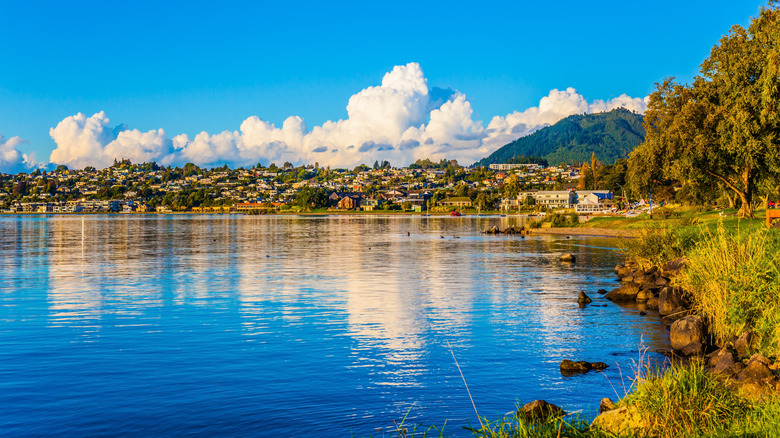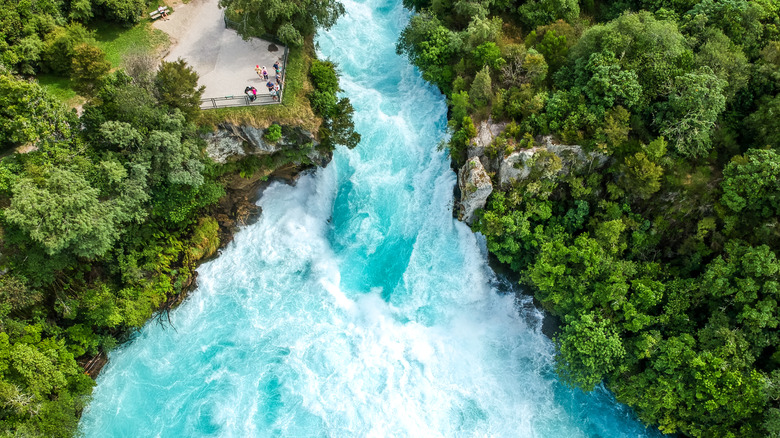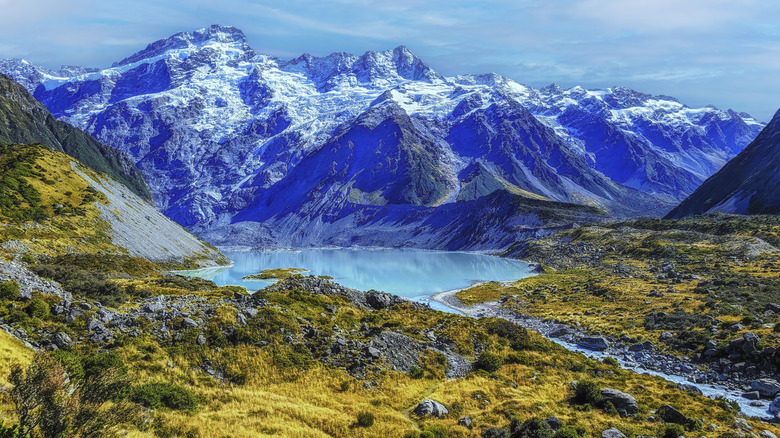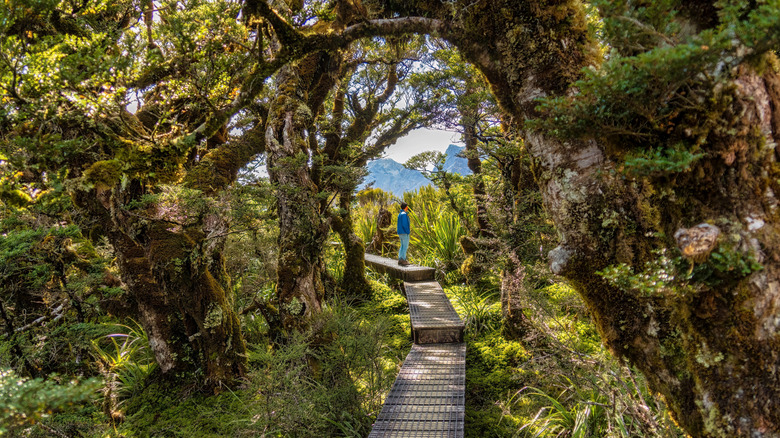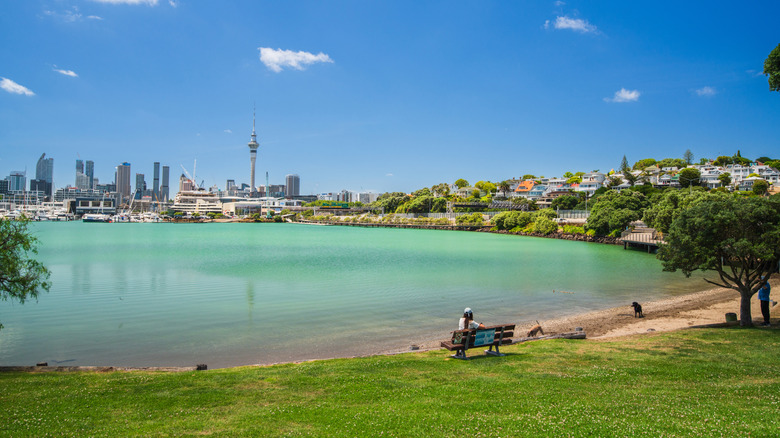The 11 Best New Zealand Destinations For Adventurous Tourists To Explore
We may receive a commission on purchases made from links.
New Zealand is unlike any other country in the world — in fact, it isn't even near any other country in the world. Its closest neighbor, Australia, stands over 900 miles away across the Tasman Sea. This means that The Land of the Long White Cloud, as the native Māori people have long called it, includes many features that are seen nowhere else on Earth. Hector's dolphins, yellow-eyed penguins, and kiwi birds are some of the species that can only be found in New Zealand. It also boasts practically no poisonous wildlife — as you probably know, the same cannot be said for Australia.
Even though New Zealand is among the safest countries for travelers, it still offers plenty of thrilling adventures for the most daring explorers. With its dramatic fjords, thrilling slopes, and rewarding multi-day treks, New Zealand can truly keep visitors on their toes. We've done a deep-dive into the best adventure-filled destinations that New Zealand has to offer, with excursions that appeal to hikers, skiers, paddling enthusiasts, and every kind of thrill-seeker in between.
Piopiotahi (Milford Sound), Southland
If Piopiotahi looks a scene from a movie, that's because it is. Also known as Milford Sound, this stunning area is located within the larger Fiordland National Park, which served as the breathtaking backdrop to "The Lord of the Rings" movies and "X Men Origins: Wolverine." Travelers who have explored Piopiotahi's fjords can see why these landscapes have spoken to so many creatives. The dramatic peaks, calm waters, and lush greenery of this region are absolutely jaw-dropping. But, beyond the park's natural beauty lies its unique inhabitants. Black coral, stingrays, and even bottlenose dolphins thrive in Piopiotahi. It's little surprise that Fiordland National Park, including the landscapes of Piopiotahi, are a UNESCO World Heritage Site. The park is located on the South Island, a mesmerizing paradise known as one of the safest islands in the world.
The best ways to view Piopiotahi is by signing up for a boat tour. There are number of day trips that whisk travelers into a scenic world of copious waterfalls and snow-capped peaks. Overnight cruises are also offered, which provide more time for activities like plunging into the fjords, kayaking, and stargazing. Because Piopiotahi has been so well preserved, it can be difficult to find alternative lodging nearby. Some visitors stay two hours away in the town of Te Anau, where affordable lodging can be found. The local Te Anau Airport Manapouri provides frequent service from Auckland Airport.
Lake Taupō, Waikato
If swimming on top of a volcano sounds impossible, think again. Located in New Zealand's stunning region of Waikato, Lake Taupō is a large freshwater lake that formed over the crater of a volcano. This means that the lake has both hot geothermal springs and refreshingly cool waters, making for a unique swimming experience. At Lake Taupō's Hot Water Beach, visitors can take a dip in the natural hot springs that bubble up along the shore. While access to this beach is free, several other thermal baths are also located in the region, and these come with a small admission fee.
Those looking for more traditional water-based activities can rent paddle boards and kayaks, or join a guided group paddling tour on the lake. Land lubbers will be thrilled to know that there's plenty of hiking to do at Lake Taupō, thanks to the iconic 44-mile Great Lake Trail that curves along the lake's edge.
To arrive at Lake Taupō, drive one hour from the Rotorua Airport, which provides daily local flights from other parts of New Zealand, including Auckland Airport. Spend the night in the town of Taupō, one of the world's friendliest towns. During the chillier month of August, hotels and flights tend to be more affordable, while traveling during New Zealand's summer months of December and January is often pricier.
Huka Falls, Waikato
Lake Taupō is not the only destination that promises non-stop adventure in the Waikato region. The spectacular Huka Falls are also an extraordinary sight worth seeing and exploring. The falls thunder through a forested gorge at a rate of 58,000 gallons per second, creating powerful rapids that are guaranteed to impress. To visit this unique destination by land, travelers can take the 550-foot wheelchair accessible Huka Lookout Walk to the viewing platform. The most enthusiastic of hikers can tackle the Huka Falls to Aratiatia Dam Loop, a 8.6-mile roundtrip trail that winds alongside the longest river in New Zealand — the Waikato River.
Access to Huka Falls is free, but visitors who aren't afraid of getting wet can take their adventure to the next level with a jet boat tour. "This was so much fun," reads one review of a Huka Falls jet boat tour on Viator. "The thrill, the speed, and great scenery [...] the Huka Falls were spectacular and our driver was great fun, knowledgable, and highly skilled." If you'd prefer something more mellow, there are also leisurely river cruises available. As with Lake Taupō, the nearest travel hub to the falls is Rotorua Airport.
Cathedral Cove Beach, Waikato
From heavy alpine snow to misty coastal breezes, New Zealand has some of the most diverse climates in the world. During the summer months from December through February, the northernmost coast of New Zealand offers a balmy subtropical environment. This makes the upper shores of Waikato one of the best warm weather destinations to spend the holidays.
To soak up this incredible climate to the fullest, head to the town of Hahei, where the gorgeous Cathedral Cove Beach awaits. Considered among the 50 most beautiful beaches on Earth, Cathedral Cove Beach inspires travelers with its crystal clear waters and cliff-lined shores. Its famous oceanside rock arch provides a breathtaking backdrop for swimming, relaxing in the golden sand, or joining a guided paddling tour. The 3-mile Cathedral Cove Walk zig-zags along the clifftops amid New Zealand's native forests.
Getting to Cathedral Cove Beach requires a vehicle, as the drive is around two-and-a-half hours from Auckland. Travelers who want to spend quality time in the area can find lodging in Hahei. Cathedral Cove is one of many hot spots along the Coromandel, an incredibly picturesque coastal region that is especially popular in the summer.
Aoraki (Mount Cook National Park), Canterbury
Aoraki, or Mount Cook National Park, is one of the most sublime places to enjoy the outdoors in New Zealand. The tallest mountains in the country can be found here, and around 40% of its terrain is covered in glaciers, making Aoraki one of the best places to see glaciers other than Alaska. To explore this gorgeous region, hike the challenging 3.3-mile Sealy Tarns Track, which features 2,200 steps that culminate in a breathtaking viewpoint. Day passes to Aoraki are free, but parking costs $25 NZD, or $14 USD per day. For a truly memorable experience, see the vistas from above on a helicopter tour offered on Viator — though, you'll need to budget accordingly, as prices start at over $400 USD per person.
One of the most exciting ways to enjoy Aoraki is by bike. The 195-mile Alps 2 Ocean Cycle Trail can take anywhere from one to seven days to complete, depending on your speed. Pedal past sky-high mountains, deep blue lakes, and Māori rock art to experience New Zealand's natural wonders and cultural heritage firsthand. There are various points of interest along the way, too, such as wineries and hot springs. The park is located conveniently near Mount Cook Airport, with various hotels, lodges, and inns in the area.
Mitai Māori Village, Waikato
Long before European settlers arrived in the early 1800s, the Māori people inhabited the islands that Kiwis of all backgrounds now call home. Because of this, Māori customs are central to New Zealand's heritage and way of life. In fact, protecting Māori culture is a core part of the 1840 Treaty of Waitangi — a constitutional agreement signed by the British Crown and Māori chiefs.
One of the best ways to immerse yourself in Māori culture is to visit the Mitai Māori Village in Rotorua, New Zealand. At this fascinating educational center, visitors can listen to live Māori music, play traditional Māori games, and watch cultural performances. Informational sessions on herbal medicine and local cooking techniques are also available. Foodies can wrap up their visits with a delectable meal cooked in a traditional earth oven.
A two-hour experience at Mitai Māori Village costs $139 NZD per adult, or around $80 USD, and $85 NZD per child, or $48 USD. Add-ons such as the dinner buffet and a relaxing soak in the mineral pools cost extra. "Amazing, just amazing," reads one review on Tripadvisor. "The cultural experience was beautiful and emotional! You really get a good picture of what the Māori culture is all about." The village is located conveniently near the Rotorua Airport.
The Great Walks of Queenstown, Otago
New Zealand boasts 11 Great Walks, which are multi-day walks amid surreal natural beauty. A testament to the stunning scenery around Queenstown, three of these walks begin near this iconic South Island city. Queenstown's multi-day hikes — the 37-mile Kepler Track, 20-mile Routeburn Track, and 33-mile Milford Track — take travelers past the lakes, rivers, and mountains that pepper the landscape of the South Island. Those who prefer shorter hikes can simply tackle smaller sections of the trails instead. The 2-mile Routeburn Nature Walk loop is a delightful taste of the longer Routeburn Track, inviting hikers over a marvelous suspension bridge and into an otherworldly beech tree forest.
To complete one of New Zealand's Great Walks, register online through the Department of Conservation's booking site. Because spots are limited, it is recommended that visitors make reservations for huts and campsites several weeks in advance. Those without a valid reservation may be fined, but in the off-season, bookings are not required as accommodations are first come, first served. That being said, registration is not required for day trips. Keep in mind that terrain and trail conditions vary by location and season. To navigate the area safely, hikers can hire a guide or join a group tour. Fly into Queenstown Airport to start you adventure.
Auckland
In New Zealand, visitors can experience both the call of the wild and the allure of the urban jungle. If you only have 10 days to spend in New Zealand, be sure to add Auckland to the itinerary. The 1,076-foot-tall Sky Tower is one of the city's top attractions, as it provides sweeping views of everything from the local city scape to 53 far-off volcanoes. Enjoy a meal at the sky-high revolving restaurant, or feel the ultimate adrenaline rush and base jump by wire from the edge of the tower.
Other activities in downtown Auckland include a trip to the Auckland Museum, where visitors can learn about New Zealand's fascinating history. With a collection of approximately 2,000 Māori artifacts, this museum is widely considered one of the best in the Southern Hemisphere. New Zealanders can visit the museum free of charge, but tourists must pay a small fee to enter. Downtown Auckland is located just 20 minutes from Auckland Airport by car. The city offers both the sophistication of a big city and limitless access to nature, beaches, and wildlife, making it a must-see.
Kiwi bird viewing on Stewart Island, Southland
"Is a kiwi a fruit, a bird, or a person?" goes the old joke. It's rare to find all three in one place, as New Zealand's native kiwi bird are an endangered species. Situated approximately 18.6 miles from the South Island town of Bluff across the Foveaux Strait, Stewart Island is one of the few spots on Earth where this bird still resides in spades. Visitors can explore the trails at night for a chance to spot these elusive, nocturnal birds in their natural habitat. Guided tours can improve your chances, as local guides may know the best places to see or hear them.
To get to Stewart Island, travelers can embark on the hour-long ferry departing from Bluff. Adult ferry tickets cost $125 NZD, or USD $72 each way, while children pay a reduced rate of $64 NZD, or $37 USD. Many visitors spend the night in the coastal town of Oban, the only town on Stewart Island. In addition to kiwis, the region is home to an extraordinary number of native birds, making it a bird watcher's paradise. In Oban, you'll find a modest collection of boutique hotels, cozy cafés, shops, and restaurants.
Marlborough
Some adventurers like to explore the world by hiking, biking, or kayaking. Others prefer to adventure with their tastebuds. Travelers who fall into the latter category might consider taking a journey to New Zealand's Marlborough wine region. Located across four different valleys, the Malborough wine region is known for its rich soil and delectable grapes. The region is home to 150 different wineries and dozens of varietals. From crisp sauvignon blanc to rich pinot noir, you're bound to find your vino of choice in Marlborough.
To get a feel for the region, sign up for a guided wine tasting tour with delicious snack pairings, or plan your own wine tasting itinerary and explore at your own pace. The Marlborough Wine Trail is a choose-your-own-adventure itinerary that allows you to bike or walk between wineries. To get to Marlborough, fly into the Marlborough Airport Blenheim. From here, get a rental car or reserve a private shuttle to the vineyards. The best time to visit is during the harvest season between February and April, during New Zealand's late summer and fall.
Mount Hutt, Canterbury
When it comes to downhill thrills in New Zealand, there's no place better than Mount Hutt. This fantastic hill has been rated the best place to ski in New Zealand for a decade. With a vertical drop of 2,240 feet, 40 runs, and three chairlifts, Mount Hutt provides enough variety to keep skiers and snowboarders of all levels on their toes. Those who don't ski or snowboard can still enjoy the slopes on a sled, or on the sightseeing chairlifts to the top of Mount Hutt.
Day lift passes cost around $175 NZD, or just over $100 USD per adult. However, it may be possible to get a discount by booking in advance online, or a multi-day pass if you plan to stay a while. Mount Hutt is easy to get to and is located around an hour from Christchurch Airport by car. Lodging is available in the nearby town of Methven, as well as luxurious outdoor hot springs at Ōpuke Thermal Pools and Spa, where you can soak and unwind after a long day on the mountain.
Methodology
To compile this guide of the best adventure-filled destinations in New Zealand, I drew deeply from my own experiences. Back in 2016, I was completely captivated by Piopiotahi, Lake Taupō, Huka Falls, Cathedral Cove Beach, and downtown Auckland. I also hiked the Routeburn Nature Walk, an alluring preview of Queenstown's Great Walks. But, since nearly a decade has passed since that journey, I looked to traveler reviews and incorporated the most exceptional and highly-rated experiences into this list.
The destinations featured are significant for their astounding natural beauty, their potential for adventure, and deep connection to New Zealand's heritage and history. For example, Aoraki is home to one of the most significant glacial landscapes in the world, while Stewart Island was chosen for its population of rare bird life. The Mitai Māori Village, meanwhile, stands as one of the few places that offer total immersion in Māori culture. The Marlborough wine region offers some of the best wine in New Zealand, and Mount Hutt stands out for its award-winning ski slopes. To aid in our research and ensure that our information is up to date, we relied on local resources such as NewZealand.com, Tourism New Zealand, Discover Auckland, Visit Queenstown, Love Taupō, and the Te Ara Encyclopedia of New Zealand.


